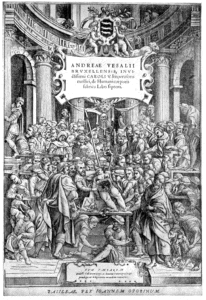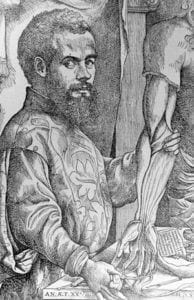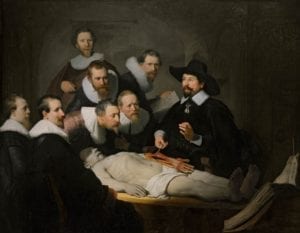Adéla Janíčková
Prague, Czech Republic
 |
| Fig 1: Anon, Frontispiece, 1543. From Andreas Vesalius, De humani corporis fabrica libri septem, 1543 |
“To extol the human hand as a monument to God’s wisdom, an instrument that permits humans to create civilization”
This statement by Dolores Mitchell1 describes the human hand as both a monument to divinity and an instrument for great accomplishments. In the medical environment of surgery and anatomical studies, physiological illustrations of the sixteenth-century anatomist Andreas Vesalius of Brussels and the seventeenth-century painting The Anatomy Lesson of Dr Nicolaes Tulp by Rembrandt van Rijn are testaments to achievements in the science of the human body. The representation of hands and its iconography were influenced by the flourishing humanities, a study which placed equal emphasis on the arts and sciences. The emblematic quality of the hand had been established in the art of Renaissance and the hand, as Mitchell suggests, is the unifying point. The divine force is, for instance, communicated through the hands of the surgeon in the Fronstispiece of Vesalius’s De humani corporis fabrica libri septem (1543). The iconification of the surgeon’s hands is further translated in The Anatomy Lesson of Dr Nicolaes Tulp (1632); however, Rembrandt subverts the positive aspect of the surgeon’s commanding hands by incorporating his own moral judgement.
Andreas Vesalius, the sixteenth-century Dutch medical reformer who contributed greatly to the constitution of the study of human anatomy as a modern science, was immortalized in the Frontispiece [Fig. 1] of his Magnum Opus De humani corporis fabrica libri septem. The portrait represents Vesalius as a discoverer of significant scientific breakthroughs achieved on dissections that he executed with his own hands. The close physical contact with the cadaver is specific for Vesalius; his hands signify a key characteristic of his professional personality and their depiction and positioning is key to understanding the holistic representation of the surgeon. In the anonymous engraving, Vesalius is depicted performing a dissection in the abdominal area of a female cadaver while surrounded by a crush of numerous eager spectators. Vesalius’s left hand is pointing towards the audience while his right hand is touching the eviscerated body; thus, the surgeon’s hands act as an instrument of mediating knowledge gained from studying the body and through the raised hand he directs it towards the crowd. Another possible reading can interpret the lifted hand as pointing upwards, as though pointing to the heavens and articulating that the study of the human body is God’s will. Combining both readings, Vesalius’s hands signify the elevation of man to divine wisdom and it is through the work of the surgeon who explores the creation of God, using his hands as the instrument. Therefore, the hands of the surgeon are represented as a sacred medium of the divine knowledge. Yet, the ownership of this knowledge is celebrated in the hands of man.
 |
| Fig 2: Michelangelo, Creation of Adam, c. 1511. Sistene Chapel |
The symbolic tendency of Vesalius’s portrait is present throughout the whole compilation of anatomical diagrams in the Fabrica. The purpose of the prints is not purely scientific and strong emphasis is placed on the decorative aspect of the illustrations. Vesalius’s mycological and osteological figures are a representation of the relationship, or fusion, of art and science. The blurred line between art and science stems from the intervention of art into the scientific realm, which took place a few decades before Vesalius’s prints, when Leonardo da Vinci and Michelangelo performed dissections on human cadavers in order to study, with an artistic objective in mind, how the interior muscles affect the exterior appearance of the body. These Italian artists, the genii of human anatomy, founded a new way of understanding and depicting the body and they disseminated these scientific discoveries into their masterpieces.
Particularly interesting is Michelangelo’s fresco work in the Sistine Chapel and specifically his Creation of Adam (c.1511) [Fig. 2]. The nearing hands of Adam and god reference the biblical giving of life by God to Adam. It symbolizes transmittance of vital essences; this does not merely represent life in the literal sense but, given the intellectual progress ignited during the Renaissance, it can by extension stand for the unique sense for cultivation that humans are endowed with. The Italian symbolic representation of human bodies in Michelangelo’s fresco or somewhere else would not have been unknown to Vesalius, particularly because he studied in Italy, at the University of Pavia and after that in Padua where he later held the chair of Surgery and Anatomy. Fabrica was published during this time. Furthermore, the prominent Paduan university, specializing in humanities and science, was home to another significant anatomist: Marcantonio della Torre. Della Torre is known for collaborating with da Vinci on his anatomical sketches. Close working relationships between anatomists and artists were established and their mutual influence is demonstrated in both scientific documents and artifacts.
 |
| Fig 3: Anon, Frontispiece, 1543. From Andreas Vesalius, De humani corporis fabrica libri septem, 1543 |
The significance of hands in Vesalius’s depiction comes to the foreground in his other portrait [Fig. 3], a woodcut by Steven van Calcar, which is known to be the only portrait authorized by the physician himself.2 This print displays a close-up image of the anatomist engaged in a dissection of the flexores digitorum muscles in a cadaver’s forearm. Since the hands are prominently presented in the surgeon’s portrait, the implications are that they do indeed have a meaning within the representational system. Also, there is a play-off as the surgeon performs a study of an arm—hands are not only acting, they are acted upon. With Michelangelo’s Creation of Adam in mind, it is as though Vesalius metaphorically takes the place of God by turning the cadaver into a scientific model and giving his “creation” a medical benefit. Although this interpretation may remain only a speculation, Vesalius’s pose was significant enough to be re-enacted by Dr. Nicolaes Tulp in the group portrait by Rembrandt. The Anatomy Lesson of Dr. Nicolaes Tulp (1632)3 [Fig. 4] suggests stylization of Tulp into the renowned sixteenth-century anatomist.4 The attempt at resemblance is striking as Dr. Tulp begins his dissection unorthodoxly on the arm instead of the abdomen, which would have been the standard first step in the procedure in order to avoid fast putrefaction of the viscera. However, an important point of difference is to be noted in the contact with the flayed arm; while Vesalius promotes the very hands-on approach, Tulp avoids contact with the cadaver.
The Anatomy Lesson was Rembrandt’s first medical portraiture.5 It was commissioned by the protagonist of the painting and six other guild members. As the patron of the painting, Tulp did have a certain degree of power over the painting; he could manipulate the image of his own persona. On the other hand, Rembrandt, as the artist and creator of the image, could leave his own imprint in the formal composition. The painter’s hand and brush as an extension of his artiste identity are an instrument to impart his opinion. In seventeenth-century Holland, the Church disapproved of human dissections and Rembrandt was a religious man, whose Catholic views were in the vein of asceticism and deep repentance. Was it a religious dilemma for Rembrandt and would the depiction of a physical intrusion of the human body have felt blasphemous? It seems as though Rembrandt’s dilemma between good and bad can be read in his masterly use of chiaroscuro—the members of the guild are represented in dark robes that blend in with the shadow of the background while the body of the dead is painted with luminous white. According to the Dutch tradition of painterly components, dark was the color of spiritual blindness whilst white symbolized inviolability.6 Moreover, Dolores Mitchell discusses Rembrandt’s identification with outcasts and other unprivileged individuals, which becomes meaningful in this context as the rather glowing whiteness of the cadaver’s body implies Rembrandt’s sympathy over the condemned soul. The dialectic of light and dark possibly identifies the imprint of the artist’s hand on the characters that the painter attributes to each figure.
 |
| Fig 4: Rembrandt van Rijin, The Anatomy Lesson of Nicholas Tulp, 1632 |
The painting carries further highly representative iconography, especially in the similitude between the surgeon’s hand and that of the dissected corpse. Dr. Tulp is depicted pulling on the ligaments of the flayed forearm with forceps while the surgeon’s other hand and his curling fingers demonstrate the action that the pulling would trigger in the cadaver’s hand by the flexor mechanism of the tendons. The controlled movement represents how the surgeon’s hand is in command of the human anatomy. Mieke Bal has stated, the painting represents “the social theater of mastery.”7 However, through this action of mimicry, the alignment of gestures draws a similarity between the surgeon, who goes against the disapproval of the Church, and the condemned criminal, whose hand, the “device” for the deed of theft, led him to the gallows. Rembrandt was a pious man and the painting seems to resist the will to represent the surgeon as an all noble man. Furthermore, Tulp’s curling hand bears another similarity with the criminal’s flayed hand in its coloring. Tulp’s hand is a tone too crimson in comparison to the skin tone used otherwise on the anatomists. On the contrary, it seems to be closer in pigment color to the flayed hand of the criminal.
In conclusion, hands have a significant position in the representation of surgeons in the sixteenth and seventeenth century. However, each symbolic iconography represents varying beliefs. In the sixteenth-century, Renaissance convictions celebrating man’s accomplishments in the scientific realm represent Vesalius’s Fabrica as a monument to the scientific man and as an instrument of connectedness between the divine and humanity. In contrast, there is a significant shift in beliefs in the seventeenth-century as a result of the Baroque period and the Church’s encouragement of arts to communicate religious themes in direct and emotional involvement.8 Rembrandt adhered to religious convictions and this seems to infiltrate into Dr. Tulp’s portrait through his unique command of color and other compositional elements. Tulp’s hand is a vessel for paradoxes.
End Notes
- Mitchell, Dolores. ‘Rembrandt’s “The Anatomy Lesson of Dr. Tulp”: A Sinner among the Righteous’. Artibus et Historiae, Vol. 15, No. 30 (1994), pp. 147
- http://vesalius.northwestern.edu/imagebrowsepages/fronticepiece.html, accessed 23/10/11
- The painting represents a combination of genres in the tradition of European painting: the group portraiture and the historical painting, in this case an account of a dissection. Dissections were held for educational and even entertainment purposes in seventeenth century Holland (Gross, 2009). Although the woodcut of Andreas Vesalius illustrating a crush of observers around the surgeon suggests that the practice of dissections as a communal spectacle was already common in the sixteenth century. The popularity of group portraiture was a unique trend of sixteenth- and seventeenth-century Holland. This was due to having no monarch who would provide financial and cultural patronage for the arts (Schama, 1987), and thus the most commonly available source of commissioned work for artist were group paintings of regents belonging to guilds or other civic institutions (Gross, 2009). Dr. Tulp together with other members of the guild commissioned the portrait to follow this bourgeois tradition, yet in a less conventional arrangement due to Rembrandt’s play on meanings as part of the positioning of the surgeons and the dissected cadaver.
- Mitchell, p. 145
- Anatomy Lesson of Dr Deijman (1656) was his second and last dissection portrayal
- Mitchell, p. 147
- Bal, Mieke. ‘Reading “Rembrandt”: Beyond the Word – Image Opposition’ (Cambridge, 1991) p. 390.
- Helen Gardner, Fred S. Kleiner, and Christin J. Mamiya, Gardner’s Art Through the Ages (Belmont, CA: Thomson/Wadsworth, 2005), p. 516
References
- Bal, Mieke. Reading “Rembrandt”: Beyond the Word – Image Opposition(Cambridge, 1991)
- Gardner,Helen;Kleiner, Fred S;Mamiya,Christin J. Gardner’s Art Through the Ages (Belmont, CA: Thomson/Wadsworth, 2005)
- Gross, Charles G. A Hole in the head: more tales in the history of neuroscience (MIT Press, 2009)
- Harcourt, Glenn. ‘Vesalius and the Anatomy of Antique Sculpture’, Representations, No. 17(Winter, 1987)
- Mitchell, Dolores. ‘Rembrandt’s “The Anantomy Lesson of Dr.Tulp”: A Sinner among the Righteous’. Artibus et Historiae, Vol. 15, No. 30 (1994), pp. 145-156
- http://vesalius.northwestern.edu/imagebrowsepages/fronticepiece.html, accessed 23/10/2011
ADÉLA JANÍCKOVÁ is a Czech art writer and adviser for multidisciplinary projects currently based in Prague, Czech Republic. She studied Art Theory at UNSW Art and Design in Sydney and received a Master‘s degree in Art History from The Institute of Fine Arts at New York University. She served as a curatorial intern at the Museum of Modern Art, editorial intern at The New Museum in New York and held positions at art galleries and an auction house.

Leave a Reply